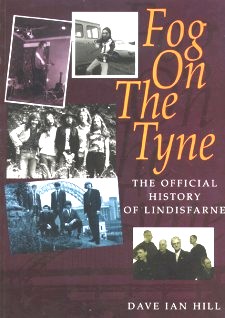

| Fog On The Tyne |
| The Official History of Lindisfarne by Dave Ian Hill |
| First published in 1998 by |
| Northdown Publishing Limited |
| PO Box 49 Bordon Hants |
| GU35 0AF |
| ISBN 1900711 07 9 - £ 14.95 |
| Copyright by Dave Ian Hill |
| Design by Simon Joslin |
| available from: www.amazon.co.uk |
With a total of 160 pages and about 150 images, Dave Hill did a remarkable job. In his own foreword he explains how he came to the 'job' of writing it. His connection to the band started after meeting Ray Laidlaw for an interview the first time at Christmas 1988 backstage at Newcastle City Hall. Later he went through tons of info material, used long forgotten articles of "Melody Maker", "Sounds", "NME" (to name only a few) and had dozens of interviews. Be it with members of the band ( one of a mammoth session with Rod at his house was going right through the night ), others like Simon Nicol, Steve Hackett, Gus Dudgeon, John Anthony, Rab Noakes, Ralph McTell, Sid Griffin are included too, or the use of Chris Groom's interview with Kenny Craddock ..... the credits for helping to create this book list more than 60 names of famous musicians or members of the music industry. And you never will have the feeling that Dave himself is telling us something. He completely avoids any own interpretation to anything listed. He simply lets it flow by using first hands stories and like a good record producer he combines everything to a tasteful brew.
Only a handful of the photos used have ever been seen in public before. Early shots of previous Lindisfarne days or various copies like the 1970/71 earnings lists or Tony Stratton-Smith's "Memorandum", all perfectly go alaong with the words.
Everything is over far too soon, but there's finally still a complete Discography which also includes Solo Discographies/Guest Appearances of "Marty Craggs", Ian Thomson", "Dave Hull-Denholm", "Billy Mitchell", "Ray Jackson", "Simon Cowe" , "Rod Clements" and last but not least Alan Hull's Guest Appearances (!!).
Well, let us thank Dave Hill one more time for giving us The Official History of Lindisfarne.
Reinhard Groll, January 1st, 1999.
Chapter 1
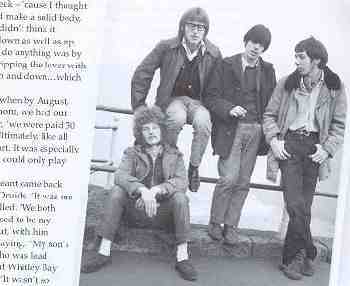 Page one starts in early summer '70 with the story of how the name
Lindisfarne was born, before the actual story begins with the first
"meeting" of Rod Clements and Simon Cowe around 1952.
Page one starts in early summer '70 with the story of how the name
Lindisfarne was born, before the actual story begins with the first
"meeting" of Rod Clements and Simon Cowe around 1952.
Then Dave Ian Hill, the author, walks very thoroughly, with a mass of details, through their first musical years until Winter '69, where Jeff Sadler the "most futuristic guitarist in the world" (according to Rod Clements) left for the final time.
Left: Downtown Faction, circa 1967, from left: Don Whittaker, Ray Laidlaw, Richard Squirrel and Rod Clements
Chapter 2
 "Dedicated" to Alan Hull. Well, if you want to see how Alan
looked in the early 1950's or he and Pat on their wedding day on Aug. 22, 1966 ..... here
you will find not only early pictures, but also how Rod and Ray felt when they met Alan
for the very first time.
"Dedicated" to Alan Hull. Well, if you want to see how Alan
looked in the early 1950's or he and Pat on their wedding day on Aug. 22, 1966 ..... here
you will find not only early pictures, but also how Rod and Ray felt when they met Alan
for the very first time.
Left: The Chosen Few (Alan on far right) find brief fame in an instrument ad.
Chapter 3
..... 'We used to start with "Eleanor" at the time,' Ray went on, 'and it was the way the thing "drips" in -first the bass, then the mandolin- well, it was really dark on stage and we were playing and playing and there was sign of Si's parts -we couldn't hear him- and we thought, "he's taking his time" ...and then one of us went over and he was asleep over his guitar! Alan was kicking his chair...'
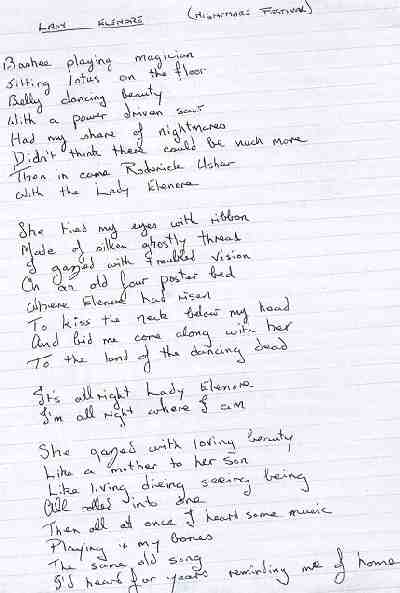 1970,
it was the year of the birth of a Lady called Elenore (see right and mind the spelling
!!!), the first press release, the first record, the first gig at the Marquee and
therefore a whole chapter is dedicated to this year.
1970,
it was the year of the birth of a Lady called Elenore (see right and mind the spelling
!!!), the first press release, the first record, the first gig at the Marquee and
therefore a whole chapter is dedicated to this year.
Right: Alan's handwritten lyrics to 'Lady Elenore'.
Chapter 4
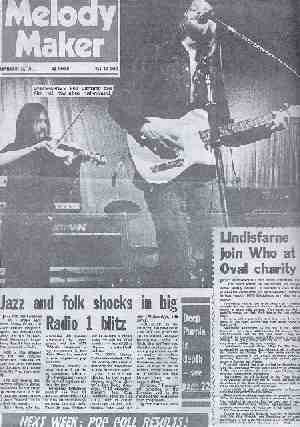
"Lindisfarne meet Genesis". A very known story, but how is Steve Hackett, Genesis' guitarist at that time, remembering those days ?
A minimum of 70 concerts during the first half of 1971 and if the reader wants to know how much Lindisfarne earned for those ......... the answer will be found on page 42 of chapter four, not in total (!!), no, every single performance with its specific earnings is listed here.
Chapter 5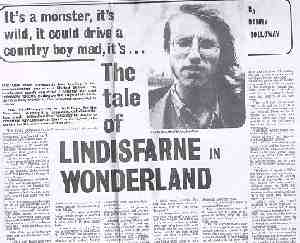
Like chapter 4 finished with the birth of the "Fog on the Tyne" album, this one titled "The Madness" openes with it. By Nov. 6th the album had reached No. 9 in the "Sounds" chart and the price for the popularity was even less leasure time.
"In 1969 I wrote 60 songs. That was when I was on the dole and cleaning windows occasionally. Since then, since we've been successful, I just haven't had the time ..." Alan commented the situation.
Chapter 5 closes with the scheduled date at which the next album recording would begin: July 13th, 1972.
Chapter 6
With giving us as so much background info about the recording of "Dingly Dell" and the troubles among it, Dave Hill did his very best to capture the mood within those days. Followed by further -being on the road- stories, including their Australian tour, together with Status Quo, Slade and Caravan and last but not least an original copy of Tony Stratton-Smith's 4-pages memorandum to the band about the current situation ( ..."you are worried that your careers may have reached a period of stagnation "...), chapter six ends with the split.

Above: Jacka, Alan Rod, Ray and Si in Lindisfarntastic pose as featured on "Melody Maker's" front page. Another photo from this session was used for the "Dingly Dell" poster.
Chapter 7
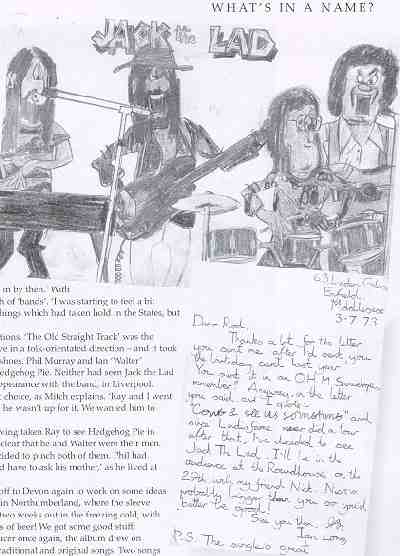 Left:
Fan acclaim for Jack The Lad, but commercial success was harder to come by.
Left:
Fan acclaim for Jack The Lad, but commercial success was harder to come by.
It had been part of the deal struck by Barbara Hayes, back in 1970, that Alan went into the studio to record "Pipedream" from 19-27 March 73.
More infos about the recording, the birth of MK II and their two recordings, plus a huge amount of information about "Jack The Lad" and finally how it came that Rod Clements played Bass on Ralph McTell's "Streets of London", all this is part of this chapter.
Chapter 8
 More
of "Jack The Lad", "Squire", "Harcourt's Heroes",
"7:84", "Radiator", the 'Reunion' of Lindisfarne to perform their
Christmas concert(s) ..... be sure, "everything" you ever wanted to know about
it. Look at pages 81-94.
More
of "Jack The Lad", "Squire", "Harcourt's Heroes",
"7:84", "Radiator", the 'Reunion' of Lindisfarne to perform their
Christmas concert(s) ..... be sure, "everything" you ever wanted to know about
it. Look at pages 81-94.
Right: Left to right: Marty Craggs, Colin Mason, Ray Jackson, Barry Spence, Charlie Harcourt.
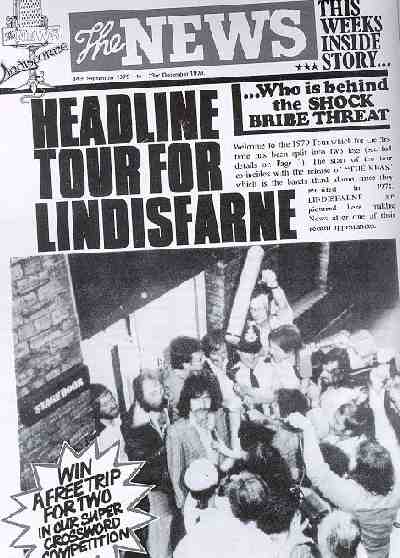
Chapter 9
From "Back and Fourth", over "The News", Jacka's solo album "In the Night", "Pacamax", "Maxie & Mitch", and finally the controversy about the cover (or actually the rear side) of "Sleepless Nights", all this could have easily filled twice the space that the 14 pages of chapter 9 do.
Chapter 10

Like for the previous chapter, there's so much to tell about this one, that even the attempt for a rough overview isn't possible, so here are only the "highlights":
Chapter 11
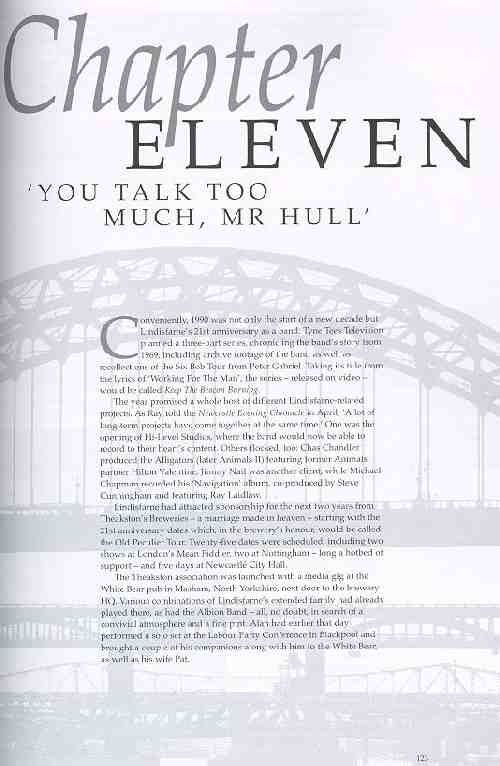 The
90's.A specific date is not named, but the situation about the event which led to Ray
Jackson's decision to leave the band, is being reported in detail. Further, who could
imagine that Si and Rod are being informed about this, two weks later, when Ray rang them
up ?
The
90's.A specific date is not named, but the situation about the event which led to Ray
Jackson's decision to leave the band, is being reported in detail. Further, who could
imagine that Si and Rod are being informed about this, two weks later, when Ray rang them
up ?
Lindisfarne's tour to Russia, starting the new album ("Elvis lives on the moon") with Kenny Craddock and stories about a lot of other gigs and festival appearances are in this chapter, too.
And suddenly there are the "new lads". How Dave Hull-Denholm (who started his 'musical roots' with playing drums) became a permanent member of the band and where Ian Thompson's started, plus the history of his relationship to Sid Griffin, all can be read here.
Right: Image of page 123; title page of this chapter
Chapter 12
This book is far from being an "Alan Hull tribute". It's about all the people who made up the "Lindisfarne family" the past 29 years, so Dave Hill did not pay too much attention to Alan's death. Therefore I only want to reproduce what Ray Laidlaw told 'Magic In The Air' at the time:
"We've been making music together for most of our lives and treasure the relationship we have built with our audience.Alan has left us a fantastic musical legacy and the most positive thing we can do for him is to ensure that his songs are performed, recorded and enjoyed." ...... ""We intend to build upon last year's solid musical foundation," Ray continued. "To do this, we need another great singer ..... there was only one candidate."
Twenty-three years after first being asked, re-enter Billy Mitchell.
So far an excerpt of the last chapter, which ends far too quickly, but still contains massive and detailed info about the past three years, for instance how Alan's "Statues and Liberties" was finished after his death, the creation of "Untapped & Acoustic", their recent recording "Here Comes The Neighbourhood" with the history of some of the songs or, finally, how Sid Griffin, the producer of "Neighbourhood" saw his work with Lindisfarne. I want to end this "little" overview with another Ray Laidlaw commentary:
"... I see this as the first of a long line of new Lindisfarne records; I don't see it as an end to it. Time will tell."
Reinhard Groll, January 1st, 1999